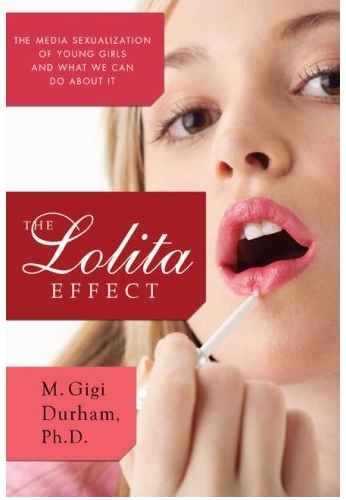 At Abercrombie & Fitch, little girls were sold thong underwear tagged with the phrases “eye candy” and “wink wink.” In Britain, preschoolers could learn to strip with their very own Peekaboo Pole-Dancing Kits — complete with kiddie garter belts and play money. And ‘tween readers of the magazine Seventeen discovered “405 ways to look hot” like Paris Hilton.
At Abercrombie & Fitch, little girls were sold thong underwear tagged with the phrases “eye candy” and “wink wink.” In Britain, preschoolers could learn to strip with their very own Peekaboo Pole-Dancing Kits — complete with kiddie garter belts and play money. And ‘tween readers of the magazine Seventeen discovered “405 ways to look hot” like Paris Hilton.
This kind of sexualization of ‘tween girls – those between the ages of 8 and 12 — in pop culture and advertising is a growing problem fueled by marketers’ efforts to create cradle-to-grave consumers, a University of Iowa journalism professor argues in her new book.
“A lot of very sexual products are being marketed to very young kids,” said Gigi Durham, author of “The Lolita Effect.” “I’m criticizing the unhealthy and damaging representations of girls’ sexuality, and how the media present girls’ sexuality in a way that’s tied to their profit motives. The body ideals presented in the media are virtually impossible to attain, but girls don’t always realize that, and they’ll buy an awful lot of products to try to achieve those bodies. There’s endless consumerism built around that.”
Durham advocates healthy and progressive concepts of girls’ sexuality, but criticizes the media for its sexual representations. Studies by the Kaiser Family Foundation and other research organizations show that sexual content aimed at children has increased steadily since the 1990s, Durham said. Times were prosperous, Britney Spears emerged as the sexy schoolgirl on MTV, and ‘tweens had plenty of disposable income — a perfect alignment for marketers trying to expand into a new demographic. By 2007, 8- to 12 year-olds’ consumer spending was $170 billion worldwide, according to the market research firm Euromonitor.
The book, published this month by Overlook Press, is the culmination of 13 years of research by Durham, an associate professor in the UI School of Journalism and Mass Communication, part of the UI College of Liberal Arts and Sciences. Publishers Weekly described “The Lolita Effect” as “well-written and well-researched,” and Booklist, the national magazine of the American Library Association, called it “provocative and erudite.”
Durham immersed herself in magazines, movies, TV shows, catalogs and Web sites aimed at young girls, from Cosmo Girl to “Hannah Montana.” She went to junior high schools to talk with girls about how the messages affected them.
In the book, Durham identifies five myths of sexuality and provides advice and resources for caring adults who want to discuss the issue with young girls.
The myths are:
–If you’ve got it, flaunt it. Bare a “Barbie body” as often as you can. But don’t celebrate or enjoy any other body type. “It’s really excluding a lot of girls from enjoying and recognizing pleasure in their own bodies,” Durham said.
–Anatomy of a sex goddess. “Media reinforce a ridiculous ideal of being both extremely thin and voluptuous — a body not found in nature,” Durham said. “You have to go through borderline starvation and plastic surgery to get it.”
–Pretty babies. Representations of sexual girls are getting younger and younger. Many of the images presented as the most sexually desirable are images of girls as young as 11 or 12. “It’s problematic in many ways: It encourages sexualization of girls too young to make good decisions about sex. It legitimizes the idea that young girls should be looked at as sexual partners. And, presenting pre-pubescent bodies as the sexual ideal pressures grown women to achieve the body of a child who hasn’t even matured yet,” Durham said.
–Sexual violence is hot. Media aimed at children — like PG-13 “slasher” movies — convey the message that violence is sexy or that sex should be violent.
–Girls don’t choose boys; boys choose girls — and only hot girls. Women and girls are supposed to focus on pleasing men. But little emphasis is placed on women taking pleasure in their own sexuality or bodies, or on guys striving to please gals, Durham said. “It’s a very one-way construction of sex.”
“The book definitely isn’t anti-sex,” Durham said. “It starts with the recognition that girls are sexual — everybody’s sexual — but that girls deserve good information that will help them make good decisions. We have the highest rate of teen pregnancy in the industrialized world, and a study by the Centers for Disease Control just reported that 1 in 4 teen girls in the U.S. has an STD. Clearly we’re not giving them the kind of information they need to take care of themselves sexually and transition to adulthood in safe ways.”
Durham encourages parents, teachers and counselors to jump-start conversations about sexualization of young girls in the media. Ask girls to look through a teen magazine and discuss the messages. How seriously do they take them? Do they understand the profit motives, or how images can be doctored to perfection?
Other tips include: complimenting girls on more than just their appearance to emphasize that they are multidimensional; encouraging activism for causes like ending sex trafficking; and assisting girls in creating their own media — Web sites, blogs or ‘zines — that are less focused on sex and appearance.
“There’s this hesitance to talk about these issues, especially before kids reach adolescence,” Durham said. “But often, when parents finally do bring it up, it’s too late. Kids have already had their sexual understanding shaped by media. We need to be having a lot of open discussions about the sexualization of childhood and what constitutes healthy sexuality. I don’t think we should neglect our responsibility as adults and leave them to navigate this terrain on their own.”
Source: University of Iowa via Newswise
